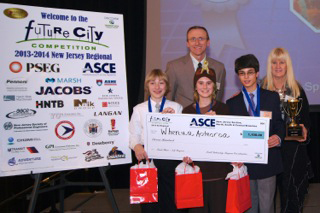Congratulations to Adam Akovity, Nigel DaSilva, and Christopher Leymeister. The students placed second at the Future City national competition in Washington DC. They also received a special award for innovative use of construction material. Over 40,000 students throughout the United States enter the competition. The team received a $5000 STEM grant.
Future City Students Advance to Nationals!
 For the fourteenth year in a row, Valley Middle School students will represent New Jersey or the New York City region at the Future City Nationals in Washington, DC. Valley Middle School has fielded many top teams through the years and last year they captured the National Championship.
For the fourteenth year in a row, Valley Middle School students will represent New Jersey or the New York City region at the Future City Nationals in Washington, DC. Valley Middle School has fielded many top teams through the years and last year they captured the National Championship.
Eighth graders Adam Akovity, Nigel DaSilva, and Christopher Leymeister, wowed the judges with their New Zealand city, Whenua Aotearoa. Valley’s second entry, Neo Diamanti, created by Dónal Gannon, Joseph Cruciata, and Anthony Mazzilli received a special award at the event. Over 400 students participated in the competition and 80 teams participated in the New Jersey Regional Competition on Saturday, January 18, at Rutgers University.
More than 40,000 students from 1,350 middle schools are participating nationwide in the regional competitions. The winning team from each qualifying regional competition receives a trip to the Future City National Finals at the Hyatt Regency Capitol Hill, February 15-18, 2014.
Their city, Whenua Aotearoa, is the historical and engineering epicenter of New Zealand, where residents and visitors can explore nature’s picturesque scenery, participate in adrenaline sports, or relax in a volcanic spring! To ensure health and safety, residents wear Safety and Health Information Bracelets (SHIBs), which record pulse, body temperature, blood pressure, and other vitals. The cross-city Super Conducting Vacuum Trains (SCVTs), Surface Skimmer integrated ferries, and electric buses are all eco-friendly and efficient transportation innovations in the city. Their Safety Scout technology ensures that there are no vehicular collisions. In addition, engineers have created a unique Manure-To-Methane (MTM) system that collects and processes the animals’ waste and turns it into methane that drives fuel cells to generate clean electric power.
Led by their teacher, Judith Vihonski, and engineer mentor, Robert Akovity students learned the basics of city planning and management as they designed a virtual city using SimCity software. This year’s theme–Tomorrow’s Transit: Design a Way to Move People in and Around Your City–asked them to review the transportation options and needs of their own city and create viable ideas that considered safety, accessibility, intermodality and sustainability in an effort to reimagine a better and more efficient city. Via the research essay, the students delved deeper into a citywide issue. From there, each team built a physical model of their city using recycled materials costing no more than $100. Teams were judged on their presentation, virtual city design, physical model, research essay and city narrative.
